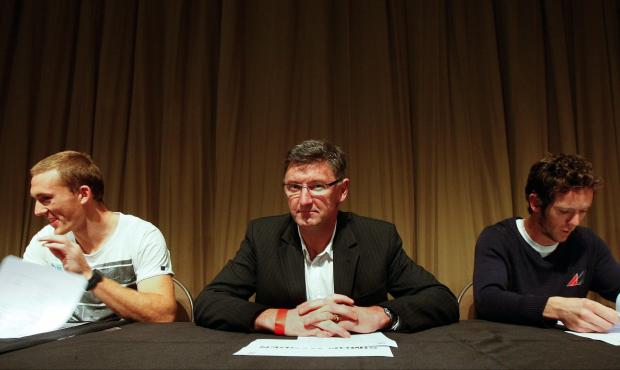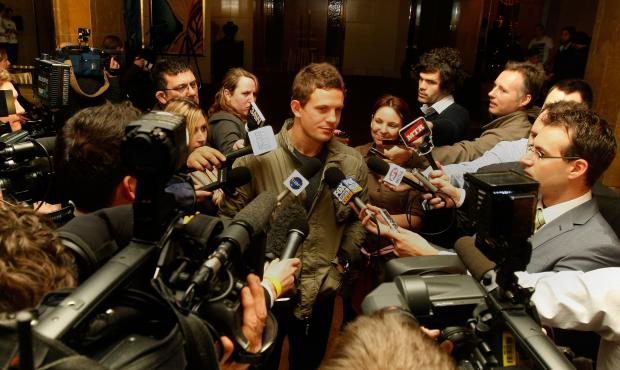The AFL Players' Association celebrates its 40th anniversary on Tuesday. In that time, it has entrenched itself as a key organisation in the industry with all players holding membership.
To commemorate the occasion, AFL.com.au lists the 10 key achievements in the organisation's history...
1. The beginning
The first general meeting is held on December 10, 1973 in order to form the VFL Players' Association. It takes place at Melbourne University and representatives from all clubs attend. Organised by Essendon's Geoff Pryor and Geelong's Gareth Andrews, it forms the basis for a meeting to elect delegates and a president in February. Pryor becomes the association's first president.
The meeting comes just four years after strike action in 1970 by Collingwood's Len Thompson and Des Tuddenham in order to secure better contracts. The players eventually returned to the team but lost their leadership positions.
2. Recognition
The VFL initially refuses to acknowledge the association's legitimacy as it prepares to fight the League's decision to abandon free transfer for players who gave 10 years service to one club (the 10-year-rule). The then-Federal Labour Minister, Clyde Cameron, intervenes on the association's behalf and the working relationship between the VFL and the association begins.
3. The threat of strike action
Players threaten to boycott the scheduled Escort Cup night series match between Essendon and Fitzroy in 1981 because the VFL wanted to once again withdraw official recognition. The strike threat forces the VFL back to the negotiating table, where the rules relating to player contracts are being debated. The VFL moves to introduce Sunday football with the VFLPA asking for compensation.
Burnout fear forced push for change
4. The player pick their champion
The VFLPA develops its most valuable player award in 1982 with Leigh Matthews winning the award for the first time. Voted on by the players, it has become a prestigious trophy awarded during the finals series. Gary Ablett junior has won five of the past seven awards. The AFLPA has also awarded the best first-year player (since 1988), the best captain award (since 1987) and the most courageous player (since 1991). In 2013, the AFLPA introduced the concept of naming the best 22 players aged 22 or under each year.
5. First collective bargaining agreement
After adopting the new name of the AFL Players' Association in order to mirror the competition's name change, the organisation enters into its first collective bargaining agreement in 1990. By the time of its next agreement in July 1992, the association secures a minimum annual salary of $7500 and minimum payments of $750 per senior game and $250 for a reserves game.
6. An important restructure
A report from Braham Dabscheck and Brendan Schwab recommends an overhaul of the organisation, with long-serving CEO Peter Allen departing and former player and successful businessman Andrew Demetriou being appointed in his place. Players are surveyed, an advisory board is established and player development, education and training, and transition from retirement become key concerns. The association reaches 100 per cent membership for the first time.
7. Indigenous and induction camps
In 2000, the AFLPA holds its first Indigenous Camp to support indigenous players and provide them with the opportunity to spend time as a group at the start of the season. Since its introduction, the AFLPA Indigenous Advisory Board and the Indigenous All-Stars game has also taken place. In 2002, the association holds its first induction camp for players new to AFL lists. Held in January, players hear from past and current players as well as experts in a variety of fields. With AFL football becoming an increasingly complex regulatory environment, the AFLPA is a key provider of education sessions to players.
8. Free agency arrives
The AFLPA negotiates a limited form of free agency that is introduced in 2012. Players are categorised as either restricted or unrestricted free agents, according to their length of service with one club and their contract status.
9. The players stand as one
Amid a tough negotiation with the AFL, the Players' Association holds a meeting in June 2011 at Crown's Palladium, with 400 players attending. The players reaffirm their support for the association's negotiating position and backs it to stick to their objectives. Fremantle captain Matthew Pavlich, an AFLPA delegate, described on the night the importance of the occasion: "It's a groundbreaking and watershed moment for the AFL Players' Association, having every single player attend a meeting," Pavlich said. Six months later, a new CBA is announced with significant salary increases, as well as extended injury, well-being and retirement schemes. The AFLPA also wins the right to review the five-year agreement after three years.
10. A better work-life balance
With concerns being expressed about the amount of down time available to players and their diminishing ability to connect with 'normal' life, the AFLPA negotiates, with the support of the AFL, to place restrictions around pre-season training for the 2013-14 off-season. Clubs are not allowed to use GPS to monitor training loads during the players' break, while one to four-year players return to training earlier than players with more experience. The association also argues successfully, with the co-operation of the AFL, for two byes per season.
AFLPA president Luke Ball addresses the media after the players' meeting in 2011. Picture: AFL Media
KEY FIGURES IN AFLPA HISTORYGeoff PryorIn 1974-75 the Essendon premiership defender was the inaugural president of the players' union.
Gareth AndrewsA co-founder of the association, the Geelong and Richmond star was president in 1975-76.
Des MeagherA tough customer, "Delicate Des" was a Hawthorn premiership player who helped establish the players' association.
Don ScottEccentric Hawthorn captain and premiership ruckman who was association president in 1977-78.
Ron AlexanderThe ruckman from Perth was president in 1979, during his six-year stint with Fitzroy. The inaugural West Coast coach in 1987.
Len CoyshFrom 1979-85, Coysh worked in the industrial relations area for the players' association.
Brian RobertsProvided legal services for the association from 1979-84.
Peter AllenOriginally employed in a joint administrative, marketing and public relations role in 1979, Allen was elevated to CEO, a role he held from 1985-98. Led the coaches' association until his death in 2007.
Michael MoncrieffThe Hawthorn premiership utility was president from 1979-87.
Simon MaddenEssendon's champion ruckman was president from 1987-90. Now the past players' representative on the AFLPA board.

Former Dons champion and AFLPA board member Simon Madden has been a key figure. Picture: AFL Media
Justin Madden
The Essendon and Carlton ruckman was president from 1990-97. As a Labor frontbencher, he has served in Victorian parliament since 1999.
Peter Mann
The North Melbourne and Fremantle key-position player was president from 1997-2000.
Andrew Demetriou
Former North Melbourne and Hawthorn player who was AFLPA CEO from 1998-2000 before joining the AFL, where he has been CEO since 2003.
Rob Kerr
Originally the executive director of player development, he stepped up to the role of CEO, which he held from 2000-2004. Now the Brisbane Lions national talent manager since July 2010.
Brendon Gale
The Richmond forward/ruckman was AFLPA president from 2000-03 before becoming general manager of football and then CEO from 2004-09. Richmond CEO since August 2009.
Peter Bell
The North Melbourne and Fremantle star was AFLPA president from 2003-07.
Joel Bowden
The Richmond utility was president from 2007-10.
Brett Burton
The high-flying former Crow was president in 2010-2011.
Luke Power
The Brisbane Lions triple-premiership player was president in 2011-12.
Luke Ball
The St Kilda and Collingwood hard nut has been president since 2012.
Matt Finnis
A former sports lawyer and administrator in basketball, sailing and surf lifesaving, Finnis was initially the AFLPA's general manager of player relations and has been CEO since 2009.

Current CEO Matt Finnis follows a long line of successful AFLPA administrators. Picture: AFL Media






